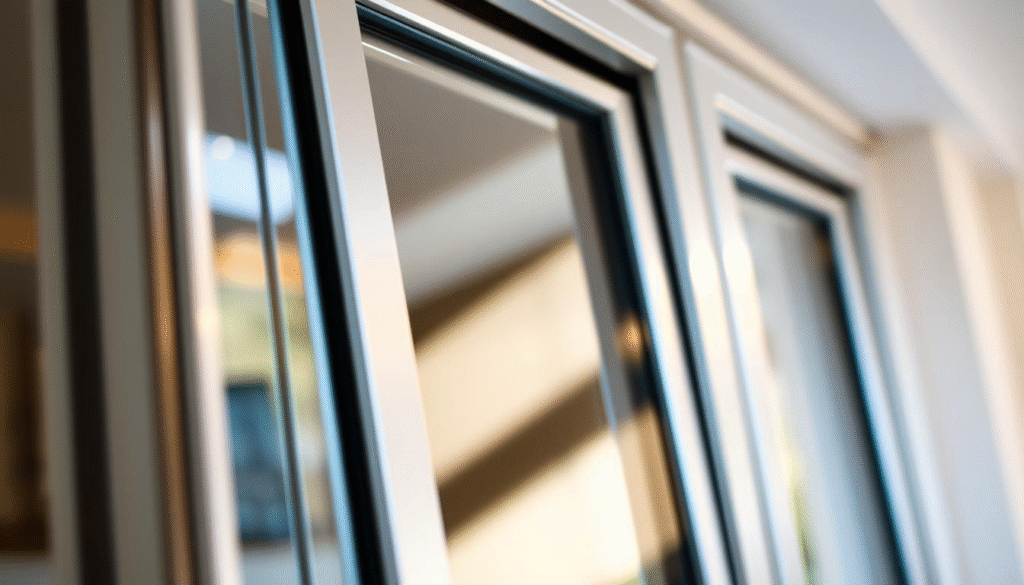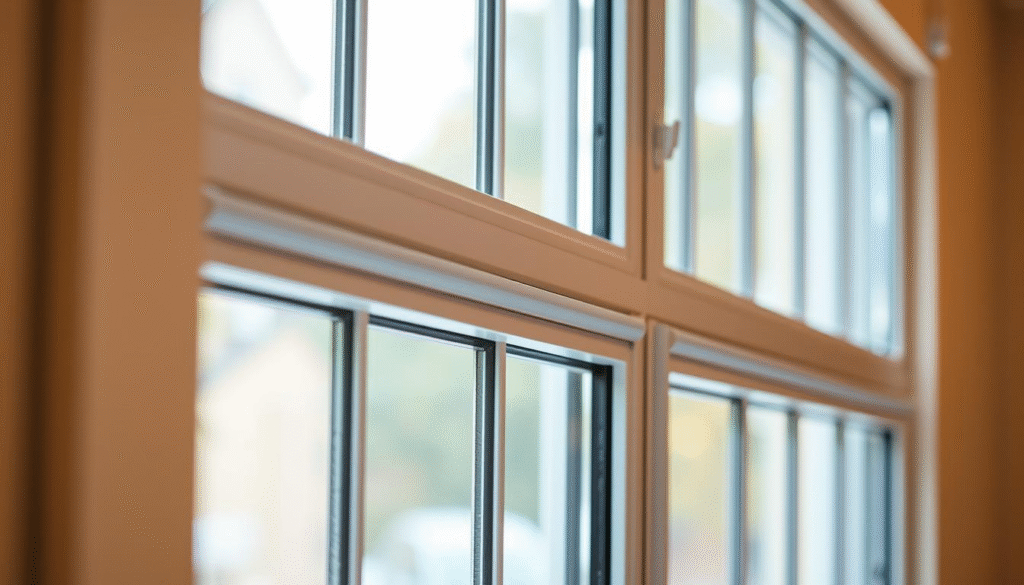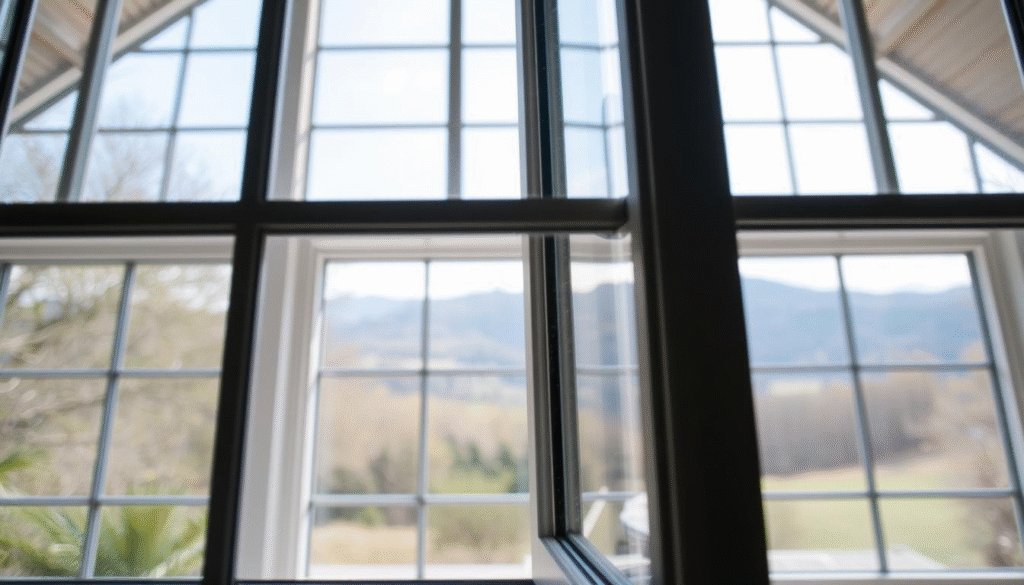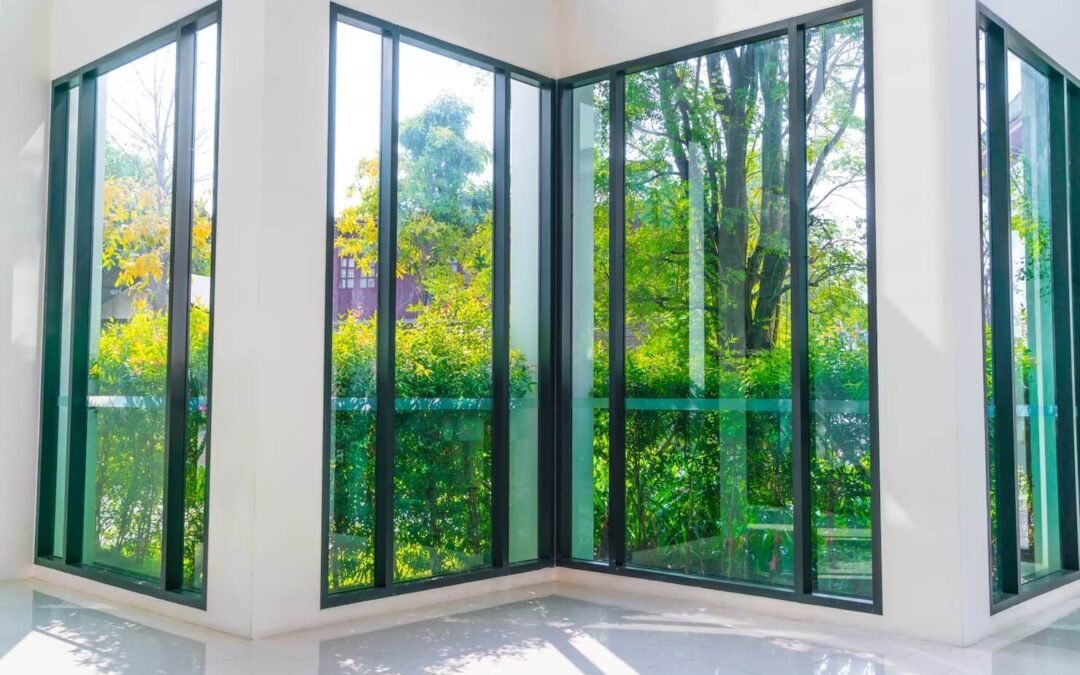Homes with double glazing can cut heat loss by up to 50%. That single stat changes the conversation about upfront price and long‑term value for many Australian homeowners.

This short guide sets clear expectations on pricing drivers and the real benefits of quality glazing. We outline what affects price — size, type, glass spec and installation — and why a well‑specified upgrade is often a sound investment for your home.
To ground the guide, Perth sample estimates (Sept 2024) show sliding frames and larger doors range from around $2,400 to $4,375. These figures exclude delivery, installation and disposal, so a site visit is essential for a final figure.
Want certainty? Call 0440 138 658 for a transparent, itemised quote tailored to your project and timelines.
Key Takeaways
- Heat loss savings and resale uplift often justify higher initial outlay.
- Size, frame type and glass spec are the main price drivers.
- Perth examples give realistic market context but exclude install fees.
- Choose reputable products and skilled installation for lasting quality.
- Get a transparent, itemised quote to avoid surprises.
At a glance: double glazed windows prices in Australia right now
Below is a concise price snapshot to help homeowners match common openings to realistic budget ranges. Use these figures as a starting guide; final quotes depend on site conditions and specification.
Typical ranges for openings by size and type
Compact awning or fixed units often start lower, while larger sliding and specialised doors sit at the top end.
| Type | Example size (mm) | Typical price (AUD) | Notes |
| uPVC awning | 600 × 900 | $537 | Product only |
| Sliding window | 1,500 × 1,200 | $2,409 | Common family room size |
| Hinged door | 2,100 × 900 | $1,271 | Standard entry |
| uPVC lift & slide | 2,100 × 3,000 | $6,163 | Large opening, high complexity |
What a “price” usually includes — and what it doesn’t
Included: the manufactured unit with standard glazing, basic hardware and factory warranty. Confirm these terms in writing.
Not usually included: delivery to site, removal and disposal of old units, installation, structural repairs or specialised hardware. Lead times can rise for custom sizes or special finishes, which affects project time and scheduling.
If you want quick ballparks and an itemised scope, call 0440 138 658 for a current, written estimate matched to your size and type preferences.
how much double glazed windows cost
Understanding the main price drivers helps homeowners make choices that balance initial spend and long‑term savings.
Key drivers of price
Size and design: Larger openings need more glass area and stronger frame profiles. That increases materials and labour.
Glass type: Options like Low‑E or toughened glass add to the price but improve thermal efficiency and durability.
Frames and finishes: uPVC is popular for energy performance and low upkeep. Premium coatings or coloured frames raise materials and price.
Installation quality: Accurate fitting, sealing and flashing are vital. Reputable installers charge for time, which protects long‑term performance.
Recent Australian market examples
- 0.70 × 0.90 m tilt‑turn — $1,701.70
- 0.50 × 0.40 m awning — $1,370.60
- 1.50 × 1.20 m sliding — $2,409
Note: Delivery, installation and removal of old units can add to the final figure. Get an itemised, site‑measured quote to avoid surprises — call 0440 138 658.
Window type breakdown: what different designs cost
Selecting the right opening type shapes both your budget and daily comfort.
Fixed units are the most economical. A basic fixed 600 × 900 mm in white uPVC is listed at $226, while a larger 1,800 × 1,500 mm fixed unit sits near $625.
Awning, sliding, tilt‑and‑turn and fixed
Awning models balance airflow and security. Example prices: 600 × 900 mm $537; 900 × 1,200 mm $1,025.
Tilt‑and‑turn units use complex gear for better sealing and function. Expect higher figures: 600 × 900 mm $477; 900 × 1,200 mm $668.
Sliding types are common for family rooms. Typical prices: 900 × 1,200 mm $705; 1,800 × 1,500 mm $1,148.
Doors and larger openings
Hinged and French doors are mid‑range; hinged at $1,271 and French at $1,857 for standard sizes.
For wide spans, advanced systems move prices up. Two sliding panels $2,696; triple stacker $2,603; lift & slide can reach $6,163.
When complex mechanisms raise the price
Multi‑point locking, Low‑E glass and extra sashes add to materials and labour. These items improve thermal performance and security, which often justifies the extra spend.
“Choose a design that balances ventilation, daylight and budget; ask for itemised specs to compare like‑for‑like.”
| Type | Example size (mm) | Indicative price (AUD) | Notes |
| Fixed | 600 × 900 | $226 | Most affordable |
| Awning | 600 × 900 | $537 | Good ventilation |
| Tilt & Turn | 900 × 1,200 | $668 | Higher sealing & function |
| Lift & Slide | 2,100 × 3,000 | $6,163 | Large span, premium gear |
For tailored advice on design, frames and glass packages, call 0440 138 658 for a written quote.
Real-world examples: indicative prices by size and configuration
Real, size‑based examples help homeowners see which openings fit their budget and lifestyle.

Compact openings: 600 × 900 mm and 900 × 900 mm
Small bedroom or bathroom openings are the most economical place to start. A 600 × 900 mm fixed uPVC unit is listed at $226.
An awning at that size is around $537, while a tilt‑and‑turn sits near $477. At 900 × 900 mm, expect fixed at $265, awning $572 and tilt‑and‑turn $522.
Family‑room sizes: 900 × 1,200 mm to 1,800 × 1,500 mm
Larger openings shift the figures because of more glass, bigger frames and extra hardware.
For 900 × 1,200 mm examples: fixed about $320, sliding (fixed slide) $705, awning $1,025, tilt‑and‑turn $668.
At 1,800 × 1,500 mm, fixed is roughly $625, sliding $1,148, awning $1,497 and tilt‑and‑turn $1,086. Note a Perth sample (Sept 2024) lists a 1.50 × 1.20 m sliding at $2,409 as a market reference.
- Use these figures as baselines — different glass or frames change final sums.
- Smaller openings: fixed is cheapest; operable types add ventilation for moderate premiums.
- For family rooms, sliding and awning designs balance airflow and floor space but will affect final numbers.
- Heat control improves with better glass; expect higher initial outlay for greater comfort.
For a personalised size‑by‑size estimate, call 0440 138 658 and list your sizes and preferred configurations.
Glass options and glazing performance
The right glazing package changes how a room feels, sounds and performs across seasons. Choices here strongly affect thermal comfort, safety and long‑term value.
Standard, Low‑E, toughened and laminated
Standard glass gives basic daylight and clarity at the lowest price. It suits sheltered rooms where security and high insulation aren’t priorities.
Low‑E coatings reflect infrared heat and improve energy efficiency, reducing heat loss in winter and heat gain in summer. This option raises the upfront price but often pays back via lower heating and cooling use.
Toughened and laminated panes add safety and security. Toughened glass resists impact; laminated glass holds fragments and improves acoustic performance. Both are recommended for ground‑level openings and doors.
Gas fills and advanced coatings
Inert fills (argon, krypton) and magnetron coatings boost insulation by cutting heat transfer across the gap. They also help reduce condensation by keeping the inner pane warmer.
Thicker panes, laminated interlayers and optimised air or gas gaps improve noise attenuation for homes near traffic or activity.
- Match glass choice to orientation, shading and local climate for best results.
- Thermal, acoustic and safety goals often overlap — a balanced spec delivers multiple benefits.
- Heating and cooling efficiency relies on frames and airtight installation as much as the glazing itself.
For advice on the best glass package for your home, call 0440 138 658.
Frames and finishes: uPVC, aluminium and colour choices
Frame selection affects energy performance, appearance and long‑term upkeep.
Choosing between uPVC and aluminium shapes thermal performance, maintenance needs and delivery times. The right pick also supports your overall design and perceived quality.
uPVC vs aluminium: cost, insulation and maintenance
uPVC is durable, low maintenance and offers strong thermal performance. Standard colours are White, Cream, Golden Oak, Anthracite and Black Smooth. Special‑order finishes expand options but can extend lead times and add to cost.
Aluminium is slimmer, ideal for modern frames and large spans. Powder‑coated finishes give a full palette and excellent durability. Thermal breaks and quality gaskets are vital to preserve efficiency.
Popular colours and finish effects
Wood‑grain uPVC and powder‑coated aluminium mimic timber tones while keeping low upkeep. Consistent finishes across doors and windows create a cohesive facade.
“Match material and finish to climate, security needs and long‑term maintenance goals.”
| Feature | uPVC | Aluminium |
| Thermal performance | High with multi‑chamber profiles | Good with thermal breaks |
| Maintenance | Low | Low to moderate |
| Colour options | Standard palette + special order | Full powder‑coat range |
| Best for | Energy efficiency, coastal UV stability | Large spans, slim sightlines |
Security improves with robust frames, multi‑point locking and laminated glazing. For samples and a side‑by‑side specification comparison, call 0440 138 658.
Installation, site work and hidden extras to budget for
Site work and installation often decide the final invoice more than the product tag. A tidy plan at measure stage cuts surprises and keeps the project on track.
Delivery, removal and disposal of old units
Typical exclusions such as delivery, hire of access equipment and disposal of old windows can add significant sums. Ask for these line items up front so you see the full costs.
Structural repairs, hardware upgrades and compliance
Removal can reveal rot in frames, lintel movement or degraded surrounds. These repairs, plus upgraded locks or safety glazing, will change the final sum.
- Confirm site access, parking and power to avoid variations.
- Discuss noise goals — acoustic glazing or seals affect installation approach.
- Coordinate trades if plastering, painting or cladding interfaces are needed.
Best practice: get a written, itemised quote that lists labour, materials and provisional sums and states warranty terms. Avoid hidden extras — ask for a line‑by‑line quote at 0440 138 658.
| Item | Common exclusion | Impact |
| Delivery | Not always included | Adds to price on remote sites |
| Removal & disposal | Often extra | Site clean‑up and waste fees |
| Structural repair | Measured on site | Can delay schedule and raise cost |
| Hardware & compliance | Upgrades billed separately | Improves safety and warranty |
Repairs, replacements and how existing conditions affect cost
A clear site inspection tells you whether repair or full replacement is the better value. Early assessment avoids hidden surprises and gives a fair schedule and price estimate.

When repairing old frames is cost-effective
Repair makes sense if frames are square and timber or uPVC has minor damage. Small rot pockets, loose seals or worn hardware can be fixed for less than a full swap.
Upgrading for longevity, security and performance
Significant rot, twisted openings or failing sills usually push the balance to replacement. Modifying a poor frame raises labour and material demands and increases total costs.
Key upgrade options:
- Replace single panes with laminated or toughened glass to lift safety and acoustic performance.
- Fit multi‑point locks and reinforced frames to improve security and durability.
- Upgrade seals and drainage for better thermal and weather performance.
“Request line items that separate repair allowances from new product prices to compare true value.”
| Condition | Likely action | Impact on budget |
| Minor damage | Repair seals & hardware | Low extra costs |
| Moderate rot | Partial frame replacement | Moderate costs, improved longevity |
| Severe structural | Full replacement | Higher upfront, lower lifecycle costs |
Book an on‑site assessment and written recommendations on 0440 138 658.
Double glazing vs single glazing: upfront cost and lifetime value
Choosing between single pane and paired‑pane glazing means weighing a higher upfront purchase against years of lower running bills.
Energy efficiency, comfort and noise reduction gains
Paired‑pane glazing lowers heat transfer and can cut heat loss by up to 50%. That reduces reliance on heating and cooling systems and improves comfort.
Rooms stay warmer in winter and cooler in summer. Condensation risk falls, protecting paint and furnishings.
Laminated or thicker panes improve noise control. For homes near busy roads, acoustic glazing often outperforms single pane options.
Impact on energy bills and property value over time
Energy bills can drop by as much as 30% with a well‑specified upgrade. Those reductions compound over years and help offset the higher initial outlay.
Property value and buyer appeal also rise; modern, efficient units typically boost resale by around 10% on average.
| Feature | Single pane | Paired‑pane |
| Heat loss | High | Up to 50% lower |
| Energy bills | Higher | Up to 30% lower |
| Noise reduction | Low | Good with laminated glass |
| Condensation | More likely | Reduced risk |
“Consider lifecycle cost, not just the initial invoice, when choosing glazing for comfort, savings and resale value.”
Get a lifecycle comparison tailored to your orientation and specification — call 0440 138 658 for a written payback estimate.
Regional insights: Perth pricing context within Australia
Perth’s market shows distinct pricing and supply patterns that matter when budgeting for glazing upgrades. Local sample figures from Sept 2024 help set realistic expectations for homeowners planning work in WA.
Recent sample prices and what moves them
Typical Perth examples: a 1.50 × 1.20 m sliding at $2,409, a 0.50 × 0.40 m awning at $1,370.60, a 0.70 × 0.90 m tilt‑turn at $1,701.70, an entrance door 1.00 × 2.10 m at $3,287.90 and a 2.40 × 2.03 m sliding door at $4,375.80.
Price movement in WA depends on a few clear drivers. Larger size and complex frames raise material and labour needs. Premium glass specs and special finishes add to the supplier lead time and price. Tough site access or required structural repair also pushes figures up.
uPVC remains popular in Perth for its low maintenance and strong thermal performance in coastal conditions. That preference influences typical specifications and local supply lines.
“Energy performance, compliant installation and quality frames are part of the local value equation — they protect comfort and property value.”
| Driver | Effect on price | Perth note |
| Size & complexity | Higher materials & labour | Large spans often need bespoke frames |
| Glass specification | Premium adds to price | Low‑E or laminated common for comfort |
| Frame finish | Colour/special order increases lead time | uPVC popular; aluminium for slim sightlines |
| Installation access | Site work raises total | Hard‑to‑reach jobs need scaffolding |
Perth homeowners see energy bill savings and improved comfort with well‑specified paired panes and quality installation. Plan ahead: special colours or large spans may delay delivery. Get a written, itemised quote that lists delivery, removal of old units and installation to avoid surprises.
For current Perth pricing and lead times, call 0440 138 658 for a region‑specific, itemised estimate.
Timeline and process: from quote to installation
Start with a free site measure and quote on 0440 138 658. This gives a clear schedule from manufacture to final handover and sets realistic expectations.
End‑to‑end process: an enquiry leads to a detailed measure and specification confirmation. You receive a written quote that lists inclusions, exclusions and terms.
On acceptance the unit is manufactured. Special finishes or larger bespoke pieces increase lead time, so plan accordingly. Clear communication on window and door schedules keeps the project on track.
Installation day: the team protects interiors, removes old units as arranged, fits the new glazing and completes finishing. A final quality check and operating guidance follow.
- Enquiry → measure → specification review
- Written quote → acceptance → manufacture
- Delivery → professional installation → final check
Payment milestones align with manufacture and installation to keep budgeting transparent. Confirm delivery windows, access and disposal before work begins.
“A thorough measure and pre‑install check reduces variations and unexpected extras.”
| Stage | What to confirm | Typical impact |
| Measure & quote | Sizes, glass spec, terms | Reduces on‑site variations |
| Manufacture | Lead time for finishes | May extend project time |
| Installation | Access, disposal, protection | Smoother fit and finish |
For a reliable timeline and a written quote, book a measure on 0440 138 658. Expect clear documentation, warranty papers and a final sign‑off on quality and operation of your double glazed window units.
How to get an accurate quote without surprises
A tight brief saves time and keeps final invoices close to the original estimate. Start by defining the product, finish and installation scope before you request pricing.
What to ask: inclusions, warranties and installation quality
Request an itemised quote that lists product, delivery, installation and disposal. Ask if any allowances cover repairs, scaffolding or compliance work.
Confirm product and installer warranties in writing. Verify glass types (for example Low‑E or laminated), frame finish (powder‑coat aluminium or uPVC colour) and hardware make.
Comparing like‑for‑like specifications
Fix the specification—glass, frame, colour, locks and ventilation—so prices are comparable. Ask for energy and acoustic ratings to match performance goals to the price.
- Clarify timelines, site access and provisional sums to avoid surprises.
- Compare payment schedules, lead times and after‑sales support, not just headline prices.
- Remember single glazing quotes are not directly comparable to paired panes; ensure the scope is the same.
“Ask for a clear, itemised brief and a written warranty to protect your home and budget.”
Get an itemised, like‑for‑like quote today on 0440 138 658.
| Checklist | Confirm |
| Scope | Product, delivery, install, disposal |
| Specification | Glass type, frame finish, hardware |
| Assurance | Warranties, installer credentials, performance ratings |
Ready to price your project? Get a transparent quote today on 0440 138 658
Secure a no‑surprises quotation that matches performance goals to your home’s needs. We provide transparent, detailed pricing with no hidden fees. Paired panes can reduce heat loss by up to 50%, cut energy bills by up to 30% and may lift property value by around 10%.
Request an itemised quote that lists product, delivery, installation and disposal so you understand total cost before you commit. Discuss comfort, security and efficiency targets and choose the right glazing, frames and hardware for your rooms and orientation.
See real savings, improved comfort and stronger long‑term value. Call 0440 138 658 now for a written, no‑pressure quote tailored to your home. Get started with clear terms, a realistic schedule and responsive support from measure to handover.
FAQ
What factors most influence the price of double glazed windows?
Size, frame material (uPVC or aluminium), glass type (standard, Low‑E, laminated or toughened), gas fill and any specialised coatings are the main drivers. Installation complexity, site access and required structural work also raise the final figure.
What’s typically included in a quote and what’s extra?
A clear quote usually covers supply of frames and sealed units, delivery, basic installation and standard hardware. Extras often include removal and disposal of old frames, structural repairs, specialised finishes, powder-coating, upgraded handles or locks, and any council compliance fees.
How do uPVC and aluminium compare in price and performance?
uPVC often costs less and offers strong thermal performance with low maintenance. Aluminium can be pricier, especially with thermal breaks and powder-coating, but it gives slimmer sightlines and greater strength for large openings.
Which glass options help reduce energy bills and noise?
Low‑E glass with a warm-edge spacer and argon or krypton gas fill improves insulation and lowers heating demand. Laminated glass and thicker panes with gas fills are best for noise reduction.
When will replacing frames be more cost-effective than repairing?
Replace when frames are warped, corroded, or have widespread rot and when sealing has failed. New frames deliver better thermal performance, security and often lower lifetime maintenance costs compared with repeated repairs.
Do larger doors and stacker systems cost significantly more?
Yes. Larger sliding doors, stackers and lift‑and‑slide systems use heavier hardware, stronger frames and precision installation, so expect a marked price increase versus standard windows.
What hidden extras should I budget for during installation?
Budget for removal and disposal of old units, minor structural work, patching and repainting, scaffolding or elevated access, and upgraded locks or flyscreens. Also allow for waste disposal fees.
How do glass coatings and gas fills affect pricing?
Low‑E coatings and argon or krypton fills add to the unit price but improve U‑values and comfort. Toughened or laminated safety glass and acoustic laminates cost more but add safety and noise control benefits.
Will new glazing increase my property value and reduce bills?
Upgrading sealed units and frames improves energy efficiency, reduces drafts and noise, and often boosts market appeal. Over time, savings on heating and cooling can offset a portion of the initial investment.
How long does a typical replacement project take from quote to finish?
From accurate quote to installation completion, small projects can take 2–6 weeks. Custom orders, powder-coating or specialised glass may extend lead times to 6–12 weeks. Onsite installation for a single window may be a few hours; larger jobs take days.
What should I ask suppliers to ensure like‑for‑like quotes?
Ask for specifications of glass type, spacer, gas, frame material and thickness, hardware brand, installation scope, removal of old units, warranty length and what is excluded. Request thermally rated U‑values and acoustic ratings where relevant.
Are warranties and certifications important?
Yes. Look for manufacturer warranties on frames and sealed units and installer guarantees for workmanship. Ensure compliance with Australian standards for glazing and any energy-rating documentation.
How do regional markets — for example Perth — affect pricing?
Labour costs, supply access and demand vary by region. Perth can differ from eastern states on lead times and freight charges, so regional sample prices often adjust for local market conditions and installer availability.
Can I get a transparent fixed quote over the phone or do you need a site visit?
Basic ballpark figures can be given by phone, but accurate fixed quotes require site measurements, inspection of existing frames and discussion of finishes, hardware and access, often needing a site visit.
What phone number should I call for a transparent quote today?
For a clear, itemised quote, call 0440 138 658 to discuss specifications, warranties and lead times with a local supplier.

